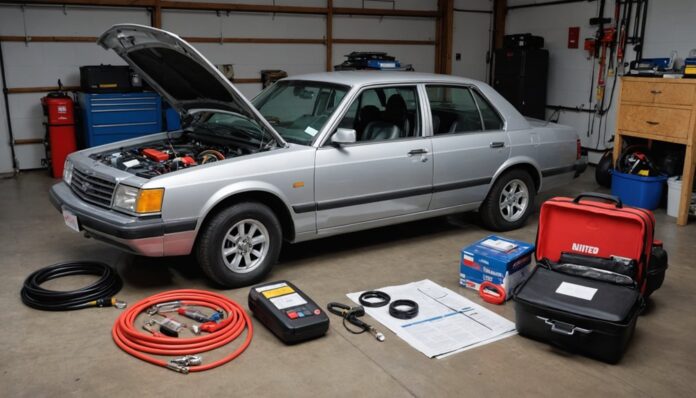Proper vehicle preparation is vital for a safe and enjoyable long road trip. Before starting on an expedition, it is essential to perform a series of checks to guarantee the vehicle is in good working condition. This includes inspecting the brakes, battery, and tires, as well as verifying fluid levels and the condition of belts and hoses. Neglecting these checks can lead to unexpected breakdowns and compromise safety. A thorough examination is just the beginning.
Highlights
- Conduct a thorough brake inspection to ensure safe stopping capabilities and check brake pads, rotors, and fluids.
- Check the battery condition and age, clean terminals, verify water level, and test the charging system.
- Inspect tires for tread depth and air pressure, and evaluate the condition of belts and hoses for signs of wear.
- Perform oil and fluid checks, including regular oil changes, and verify fluid levels are at recommended levels.
- Build a roadside emergency kit with essentials like roadside flares, jumper cables, spare tire, and tire-changing equipment.
Essential Vehicle Checks
Before starting a long road trip, it is essential to confirm the vehicle is in good working condition to minimize the risk of breakdowns and guarantee a safe travel experience.
A brake inspection is critical to ascertain the vehicle can stop safely. This involves checking the brake pads, rotors, and fluids to guarantee ideal braking performance.
A battery check is also important to prevent unexpected dead batteries. This includes verifying the battery terminals are clean, the water level is adequate, and the charging system is functioning correctly.
Additionally, checking the tires, oil, and fluids can help identify potential issues before they become major problems.
Conducting these essential vehicle checks can provide peace of mind and help guarantee a smooth, enjoyable trip.
Pre-Trip Car Maintenance Tasks
Inspecting and addressing key vehicle systems is essential to guaranteeing a trouble-free road trip. A thorough brake inspection is imperative to assure safe stopping. This includes checking brake pads, rotors, and fluid levels to identify any potential issues.
A battery check is also essential, as a dead battery can leave drivers stranded. The condition and age of the battery should be assessed, and the charging system tested to verify it’s functioning correctly.
Additionally, belts and hoses should be inspected for signs of wear, and the condition of the tires, including tread depth and air pressure, should be evaluated.
Oil and Fluid Checks
While a well-maintained vehicle is essential for a successful road trip, one of the most important aspects of pre-trip preparation is often overlooked: oil and fluid checks.
Regular oil changes are key to extending the life of a vehicle’s engine, as dirty oil can cause damage and even lead to engine failure. In addition to engine oil, other necessary fluids such as coolant, transmission, and brake fluid should also be checked.
Drivers should verify that all fluid levels are at the recommended levels and top them off as needed. Neglecting these checks can result in costly repairs, road trip delays, or even safety hazards.
Prioritizing oil and fluid checks before starting a long road trip can guarantee a smooth and enjoyable expedition.
Tire Pressure and Condition
Making certain the vehicle’s tires are in ideal condition is essential for a safe and enjoyable road trip, as properly maintained tires can improve handling, fuel efficiency, and overall road safety.
Drivers should inspect their tire tread depth, looking for signs of uneven wear or excessive wear. Adequate tire tread is significant for maintaining traction on the road, especially in inclement weather conditions.
Additionally, checking air pressure is important, as underinflated tires can lead to reduced fuel efficiency, increased risk of tire failure, and compromised handling. Vehicle owners should consult their owner’s manual for recommended air pressure levels and adjust accordingly.
Safety Inspections and Repairs
Beyond tire pressure and condition, another fundamental aspect of preparing a vehicle for a long road trip is addressing any potential safety concerns through thorough inspections and necessary repairs.
A detailed brake inspection is essential to guarantee the vehicle can stop safely and efficiently. This includes checking brake pads, rotors, and fluid levels.
Additionally, verifying light functionality is critical to maintain visibility and communicate with other drivers. This includes headlights, taillights, brake lights, and turn signals.
Any malfunctioning lights or brakes should be repaired or replaced before starting the trip. By addressing these important safety components, drivers can greatly reduce the risk of accidents and guarantee a safe voyage for themselves and their passengers.
A well-maintained vehicle can provide peace of mind and a sense of belonging on the road.
Building a Roadside Emergency Kit
Numerous unforeseen circumstances can arise during a long road trip, making a well-stocked roadside emergency kit an indispensable component of any vehicle’s equipment.
A roadside emergency kit should include items that enable drivers to signal for help, jump-start their vehicle, and make basic repairs. Roadside flares are essential for alerting other drivers to a stranded vehicle, especially in low-light conditions. Jumper cables are also a must-have, as they allow drivers to jump-start their vehicle if the battery dies.
Additionally, the kit should include a spare tire, tire-changing equipment, and a basic toolkit. It is also important to check the kit regularly to verify that all items are still in working order and that the supplies are not expired.
First Aid and Medical Supplies
A long road trip can be an unforgiving environment, making it imperative for drivers to prioritize the health and well-being of all passengers.
Assembling a first aid kit is a significant step in preparing for potential medical emergencies that may arise during the excursion. This kit should include basic medical supplies such as bandages, antiseptic wipes, pain relievers, and any prescription medications that passengers may require.
It’s also important to include supplies for treating common road trip ailments, such as motion sickness and minor injuries. By including these important medical supplies, drivers can help guarantee the comfort and safety of all passengers, creating a sense of security and belonging on the open road.
Regularly checking the expiration dates of medical supplies is also imperative.
Navigation and Communication Tools
While a well-stocked first aid kit can help address medical emergencies, it is equally important for drivers to be equipped with the necessary tools to steer and communicate effectively during a long road trip.
A reliable GPS app is essential for routing, providing turn-by-turn directions and real-time traffic updates. Drivers should also invest in a car charger to keep their devices powered up throughout the expedition.
In addition to GPS apps, communication devices such as two-way radios or walkie-talkies can be useful in areas with limited cell phone reception. A fully functional phone mount is also vital, allowing drivers to safely make hands-free calls and access their GPS app while driving.
Comfort and Entertainment Essentials
When starting a long road trip, comfort and entertainment become essential aspects to evaluate, as they can greatly impact the overall travel experience.
Ensuring a vehicle is well-stocked with comfort and entertainment essentials can make a significant difference. Travelers should pack an assortment of snack options, such as non-perishable items, fruits, and energy bars, to maintain energy levels during the excursion.
Entertainment devices, including portable tablets, handheld consoles, and audiobooks, can also help pass the time and alleviate boredom. Additionally, carrying comfortable clothing, pillows, and blankets can enhance the overall comfort of the trip.
Vehicle Documentation and Insurance
Vehicle owners should verify their documentation and insurance are up to date before commencing a long road trip.
An essential step is to check the vehicle’s registration and confirm it has not expired. If it has, registration renewal is necessary to avoid potential fines.
Additionally, verify that the vehicle’s insurance coverage is active and sufficient for the duration of the trip. Consider the route and destinations, and check that the insurance policy covers the regions to be visited.
Confirming proper documentation and insurance not only provides peace of mind but also protects against unforeseen events.
Taking the time to review these essentials prior to departure will allow for a stress-free and enjoyable expedition, allowing the driver to focus on the road ahead.
Conclusion
Proper preparation is key to a safe and enjoyable road trip. By completing essential vehicle checks, performing routine maintenance, and packing necessary supplies, drivers can minimize the risk of breakdowns and guarantee a worry-free expedition. A well-prepared vehicle and informed driver lead to a successful and stress-free trip, allowing travelers to focus on the scenic route and create lasting memories. A thorough pre-trip checklist helps secure a smooth ride from start to finish.


